Dr. Maria Montessori was a big fan of field trips. In her words, it was important for students to take “outings” or to “go out.” In 1948, Dr. Montessori wrote: “The outing whose aim is neither purely that of personal hygiene nor that of a practical order, but which makes an experience live, will make the child conscious of realities … When the child goes out, it is the world itself that offers itself to him. Let us take the child out to show him real things instead of making objects which represent ideas and closing them up in cupboards.” Hence, the Montessori phrase of “going out” was born.
At Greensboro Montessori School, we take the Montessori tradition of “going out” to heart, as our students take academically aligned, overnight field trips beginning in Lower Elementary. Where lessons in the classroom are a springboard to learning, Montessori outings provide the experiences necessary to move concepts from the abstract to the concrete – to let students apply and expand their knowledge in the world around them.
As our students progress from Toddler to Junior High, they learn the rites of passage, including the field trips, which will greet them along the way. Read about all our adventures, or jump to the division that interests you most!
Lower Elementary
Beginning in second grade, Lower Elementary students take annual trips to either Earthshine Discovery Center in the Nantahala National Forest in western North Carolina or the Sound to Sea program along the North Carolina’s Crystal Coast. Second and third grade students spend two days and three nights building upon their lessons in biology, botany, environmental studies, geography, history, and physical science.
Upper Elementary
North Carolina's Outer Banks: Fourth graders travel to North Carolina’s Outer Banks where they experience the region’s rich marine biology and storied history. Students visit national landmarks like Roanoke Island, the first settlement of English colonists, and the Wright Brothers National Memorial in Kitty Hawk. In the words of the National Parks Service, Kitty Hawk is the site where Wilbur and Orville Wright “experimented with flight in the early 1900s, and finally succeed[ed] on a cold winter day with the world's first controlled, sustained, powered, heavier-than-air flight.”
Colonial Williamsburg: Fifth graders travel to Colonial Williamsburg, where they immerse themselves in the history of the American Revolution and explore, as Colonial Williamsburg puts it, “the political, cultural, and educational center of what was then the largest, most populous, and most influential of the American colonies. It was here that the fundamental concepts of our republic — responsible leadership, a sense of public service, self-government, and individual liberty — were nurtured under the leadership of patriots such as George Washington, Thomas Jefferson, George Mason, and Peyton Randolph.”
Due to class sizes and travel logistics, fifth and sixth graders will travel together this year, heading to Washington, D.C. Next year, our current fifth graders will enjoy their Williamsburg experience as sixth graders.
Washington, D.C.: Sixth-grade students head to our nation’s capital, where they visit multiple Smithsonian museums, (including the National Museum of African American History and Culture and the National Air and Space Museum), the National Archives, Arlington National Cemetery, and the National Gallery of Art and Sculpture Garden. Students expand upon their knowledge of national government and civics, while practicing grace and courtesy in a metropolitan city center. Dr. Montessori writes: “A child enclosed within limits however vast remains incapable of realizing his full value and will not succeed in adapting himself to the outer world. For him to progress rapidly, his practical and social lives must be intimately blended with his cultural environment.”
Junior High
Seventh and eighth graders rotate between annual field trips to Arizona and Costa Rica every spring.
Arizona: When students head west to Tuscon, Arizona, their years of environmental science studies take center stage during a week-long trip. In addition to hiking Kitt Peak, students spend time at the University of Arizona’s Biosphere 2, a state-of-the-art scientific facility. The mission of Biosphere 2 “is to serve as a center for research, outreach, teaching and life-long learning about Earth, its living systems, and its place in the universe; to catalyze interdisciplinary thinking and understanding about Earth and its future; to be an adaptive tool for Earth education and outreach to industry, government, and the public; and to distill issues related to Earth systems planning and management for use by policymakers, students and the public.”
Costa Rica: When students make their way to San José, Costa Rica, they enjoy an authentic immersion experience that includes living with the Costa Rican families of students from The Summit School, our sister school in Coronado, Costa Rica. Together, our students and the Ticos (a colloquial term for natives of Costa Rica) go everywhere together. They visit volcanoes, complete high ropes courses, and sail through the rainforest canopy on zip lines. They travel to the Caribbean Coast where they walk the beach at night looking for turtle eggs to bury in a nearby protected hatchery. Then, they travel to the Pacific side to snorkel and explore rain forests and animal sanctuaries. They also spend a day in downtown San José learning about Costa Rican history, art, and government. With every visit to Costa Rica, our students return with their eyes a little wider and their lives a little richer as they have their first experience actually living in another culture.
Self-Directed Travel for Ninth Graders: An important element of our ninth-grade curriculum is the completion of a year-long capstone project that challenges each student to apply their skills to an area of personal interest that will improve and enhance their world. Similar to a thesis or senior project, the capstone project provides a framework for demonstrating leadership and advanced application of critical thinking skills. To further extend their learning, the students are challenged to design a custom end-of-year outing to include research opportunities for each of their individual capstone projects. In collaboration with a faculty advisor, a past ninth grade class settled on an itinerary traveling throughout the Pacific Northwest. Their route took them to explore tidal pools, tour museums in Seattle, visit a military base in Tacoma, and interview refugees in Vancouver.
Greensboro Montessori School hosted two teacher workdays this fall, each dedicated on professional development. Classrooms were closed giving our team uninterrupted time to focus on learning new skills and growing as educational professionals. So how did the team use their time?
During our September 20 workday, faculty paused to reflect on the work we do with students every day and our approach to guiding them in their meaningful work. Nancy VanWinkle, instructional coach, and Jessica White Winger, director of student support, led a workshop designed to build teachers’ tool sets for preparing the environment, particularly expanding the resources of the prepared teacher. The theme was building a “Community of Reflective Practitioners,” with a focus on leveraging the collective experience of the educators in the room.
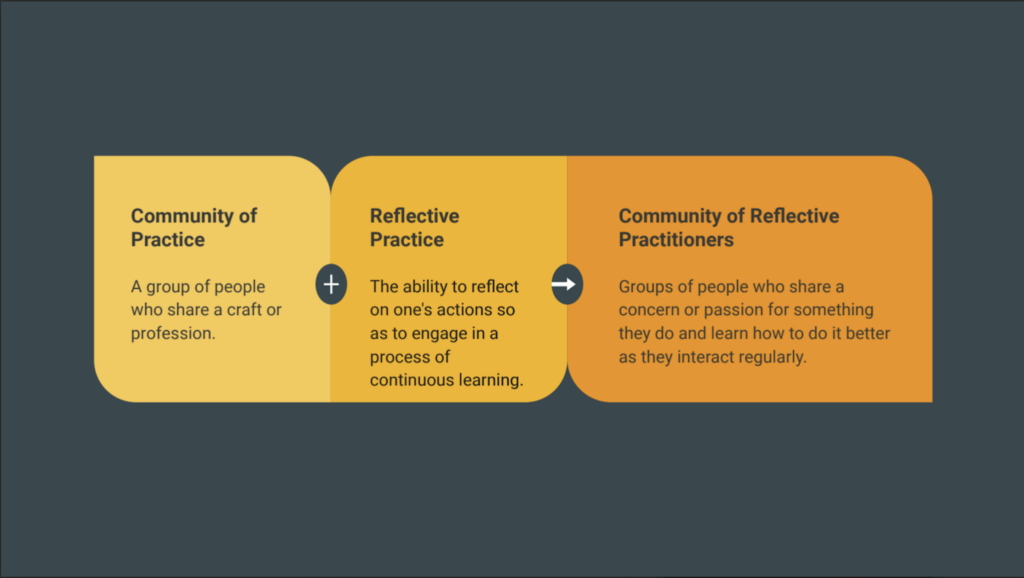
Teachers worked in mixed-division groups, with varying years of experience in the field. The morning opened with a grounding activity in which teachers were shown photographs of individuals who have affected positive change in the world. These individuals have raised awareness around difficult issues, often putting their lives and work at risk to do the “right” thing. Teachers were asked to work with their groups to list the qualities of one of those changemakers. Following a share-out, the group reflected on how we can encourage these qualities in all of our students. This impactful exercise grounded us in the knowledge that each child is under “self construction” and we have the big responsibility of allowing their true light to shine, while helping guide them in becoming their best self.
Following this exercise, Nancy and Jessica shared what resources and experiences they have to support teachers during the 2023-24 school year. As our instructional coach, a role dedicated to support faculty in their professional development, Nancy worked closely with Jessica to design a collaborative problem-solving approach for schoolwide implementation. The model offers teachers a practical tool for seeking input from one another and leveraging the cumulative knowledge of our faculty and staff.
This collaborative problem-solving model has teachers sharing a specific behavior they are experiencing with a child in their classroom. A group of educators, with one facilitator and one recorder, reflects on the overall question, “What’s going on with this child?” and what are the unmet needs, lagging skills, or obstacles that the student might be encountering? By looking at the heart of the issue, we honor the child and seek to better understand what their behavior is telling us. The facilitator then takes the group through a series of brainstorming questions, while the recorder writes strategies and suggestions. In the end, the teacher chooses a strategy to try out for a week and agrees to report back to the group. At that point, they may revisit the brainstorm and select another strategy to try.
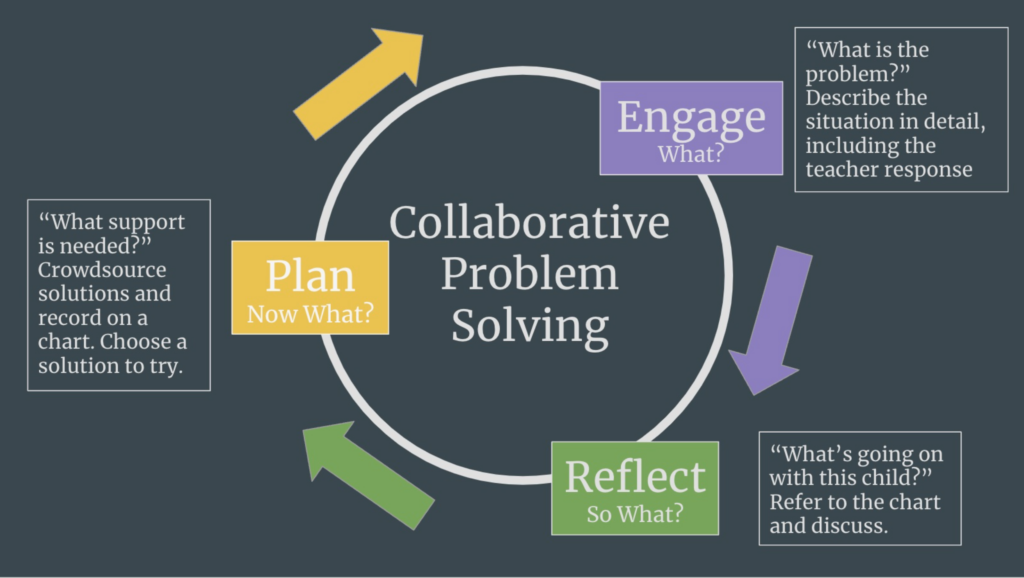
After modeling this process for everyone, teachers split into their mixed-division groups to practice the model. The value of this collaborative approach is vast, as it’s an opportunity for teachers to gain new perspectives and insight, helping create a shift in paradigm and introducing new ways of responding to student needs. It’s about connecting with colleagues and taking a child-centered approach, as much as it’s about reflecting on our own vulnerabilities and finding strength in the process. It is not about “fixing” a behavior, but opening ourselves to trying new approaches and embracing the spirit of the child.
During our October 6 teacher workday, our group of reflective practitioners reunited to share how our new system of collaborative problem solving is helping them in the classroom. Mixed-division groups reported out on strategy successes and areas of growth. More teachers had the opportunity to share a new challenge with their groups and seek strategies to try. Faculty feedback for this process has been overwhelmingly positive, and we are excited to be working closely together to authentically support students and to address their most critical needs.
Teachers spent the latter half of the workday looking at the scope and sequence of their Montessori curriculum, evaluating it with a fine-toothed comb to ensure fidelity and best-practice in every classroom. This “big work” is just one more way we are reflecting on our practice and ensuring that every student at GMS is engaged in meaningful work as they progress from Toddler through Junior High.
Through intentional planning, we make professional development at GMS relevant and meaningful. We consistently follow-up with faculty to ensure we are meeting their needs and supporting their professional growth. From workshops, trainings, and conferences to observations at other schools, professional development offers inspiration and connection for GMS teachers.
Over the course of the next few months, nearly half of the Toddlers in our School will be making a foray into the wonderful world of Greensboro Montessori School's Primary program. This transition brings with it a mixed bag of emotions for young children (not to mention their parents and teachers). Though the idea of becoming one of those big kids in the enchanting world on the other side of the playground fence can be very exciting, the thought of leaving behind beloved teachers and classmates and mastering the challenging materials in the Primary classroom can be very daunting for advancing toddlers. At times, well-meaning adults discuss this transition in ways that can actually heighten young children's apprehension. Here are a few things to consider as we prepare our little ones for a classroom transition:
Avoid "overtalking" about the impending changes. For adults, having ample opportunity to ask questions and share our feelings about an upcoming transition can be a comfort. We may worry that our children won't know what to expect from their new classroom unless we initiate frequent discussions and provide ample detail. For young children, though, too much information can be overwhelming and confusing. Because they learn experientially, young children may not grasp the reality of how things will feel in their new classroom until they have physically visited the space, met the teachers, and absorbed the sights, sounds, and sensations first-hand. It's perfectly fine to mention the change - conveying that you are excited about it and confident in their readiness for the new classroom - but, for the most part, it's best to follow your child's lead. The most helpful discussions will be the ones your toddler initiates!
Avoid tying new skills to Primary advancement. It can be tempting to entice children to practice new skills by pointing out how important they are for Primary students. However, suggestions that toddlers learn to use the potty, dress themselves, or tackle other developmental tasks "so they can go to Primary" can sometimes backfire. Even children who seem excited about the prospect of "moving up" can harbor anxieties about the transition ... and may not be so sure they really want to go. In fact, they may even delay the acquisition of self-care skills to avoid the prospect of being moved into a new and unfamiliar environment. It's wonderful to express the love and pride you feel when your child attains a new milestone, but keep the topic entirely separate from expectations that may be attached to their classroom placement.
A few setbacks are perfectly normal. At times, parents are surprised to find that their "big kids" suddenly takes three steps back in behavior, separation anxiety, or even toileting before or during classroom transitions. Don't worry; this too shall pass. Translated from the toddler speak, these setbacks are children's way of asking whether they will still get the nurturing and support they relished as infants and toddlers, even though they are heading into big-kid territory. A little extra cuddling and reassurance will help your child get back to their independent ways in time.
Rest assured, you are in for a treat! Call us biased, but we're not exaggerating when we say that the Primary faculty at Greensboro Montessori School is one of the most talented teams imaginable. You'll be astounded by the many ways your child will learn and grow during the Primary years - and by the dedication and expertise of their teachers. Watching children leave our classroom nest is the hardest part of teaching, but knowing they are going into such incredibly dedicated and capable hands makes things much easier. We can't wait to gaze at our "alumni" over the playground fence next year, and marvel at the ways they are spreading their wings!
Dr. Maria Montessori was nominated for the Nobel Peace Prize in 1949, 1950, and again in 1951. Dr. Martin Luther King, Jr. was awarded the Nobel Peace Prize in 1964, becoming the youngest man to receive the honor at the time. They were both influenced in their work for peace by Mahatma Gandhi. In the 1930’s Maria Montessori met Mahatma Gandhi while she was living in India, and Gandhi gave a speech to Montessori teachers in training in London in 1931. There he said of her work, “You have very truly remarked that if we are to reach real peace in this world and if we are to carry on a real war against war, we shall have to begin with children.” While Dr. King did not meet Gandhi in person, he referred to him as “the guiding light of our technique of nonviolent social change.”
These three peacemakers have been great influencers across cultures. Dr. Montessori established educational training programs that have led to thousands of schools all around the world. Dr. Martin Luther King, Jr. organized peaceful protests that changed civil rights laws in the United States and inspired future peaceful protest around the world. They all changed the world through peaceful efforts.
At Greensboro Montessori School, we implement the peace curriculum at every age level - from guiding toddlers to self calm to teaching peaceful conflict resolution in our preschool and elementary classrooms, to visiting the United Nations in Junior High. We seek to provide experiences for children to understand and access the peace within themselves, to relate with other people, cultures, and the environment, and to embrace the complexity of humankind. When children are given opportunities to practice peace within themselves, they will be able to share it with others and seek it out in the world.
Dr. Martin Luther King, Jr. said, “The function of education is to teach one to think intensively and to think critically.” These peacemakers have influenced generations. And inspired by their work, Greensboro Montessori School is educating the next generation of peacemakers and innovators.
Greensboro Montessori School's Upper School students took a leading role in Friday's Earth Day celebration. Upper Elementary students kicked off the morning with readings of original poetry and Spanish. After the program (which we shared live on Facebook), Junior High students hosted Lower and Upper Elementary students at eight different different stations set up on the Athletic Field. Each station featured an activity to to raise awareness for Earth Day, including ideas for recycling, composting, and even limiting our waste. Primary students enjoyed a lesson with our environmental educators, Chelsi Crawford and Sara Stratton. Toddler students took everything in from their shaded mats under the trees, just steps away from their play yards.
The original poetry shared by our Upper Elementary students highlights our integrated curriculum. Students combine their skills in English, Spanish, creative writing, science, environmental education, public speaking, and leadership all at once. We are honored to publish their work for all to experience.
Redbud Tree
Lydia, Sixth Grade
The Eastern redbud tree, purple blossoms in early spring. Small beacons of colour adorn the dull, monochromatic landscape. Bursts that spring is just around the corner.
As the blossoms begin to fade, they get swept away by the gusts of wind that spring brings. Petite purple petals pressed onto the ground as they get trampled by tiny feet. But not all is lost, leaves that are a deep crimson, like garnet, or a sharp, zesty lime the size of a hand unfurl. The leaves are shaped like spades. Desperately trying to hold onto their branches by their paper-thin stems. Through treacherous storms they hold on, not falling yet, for the leaves have roots of their own.
The redbud tree is eternally stretching, reaching its roots through the mycelium and soil, while the branches are competing for the warm rays of sunlight. The uneasy cottontail rests by the roots of the tree, protected by the lush canopy from the hungry hawks’ view.
During autumn, the leaves of the redbud tree glow orange, like a campfire. Only turning into a bonfire as the chorus of the other deciduous trees chime in in the early November. Then, the redbud tree goes to sleep as the long, cold winter days begin.
Día de la Tierra Upper Elementary Group A
- Debemos cuidar la Tierra porque es el único planeta que temenos.
- Debemos cuidar la Tierra porque es nuestra casa y nuestro hogar.
- Debemos cuidar la Tierra porque vivimos en ella.
- Debemos cuidar la Tierra porque hay animales, árboles, océanos y más.
- Debemos cuidar la Tierra porque es la casa para todos los tipos de vidas.
- Debemos cuidar la Tierra porque nos da comida.
- Debemos cuidar la Tierra porque es la casa de todos.
- Debemos cuidar la Tierra porque es muy bonita. Los humanos debemos comprender que no se debe hacer daño a la Tierra.
- Debemos cuidar la Tierra porque o si no nos extinguieremos.
- Debemos cuidar la tierra porque es nuestra protectora y nuestro hogar.
sphagnum
Tanner, Fourth Grade
The sphagnums dance in the rain like an umbrella being twirled. The sphagnums dance in the rain on the mother tree. The sphagnums dance in the rain in the rainforest. The sphagnums dance in the rain under the shade. The sphagnums dance in the rain and the damp mother tree is playing her music. The sphagnums dance in the rain, their spore capsules open up and the spores fly away. The sphagnums dance in the rain as the 10,000 ancestors watch them. The sphagnum dances in the rain, the calm green color is shimmering on as the rain falls on them, the sphagnums dance in the rain; they have no roots, stems, leaves or seeds. The sphagnums dance in the rain, they can grow until they run out of room. The sphagnums dance in the rain in their fuzzy soft coats. The sphagnums dance in the rain. They are used for medicine to save peoples lives. The sphagnums dance in the rain; they get picked and re-planted to make a garden look nicer. The sphagnums dance in the rain.
Greensboro Montessori School partners with the Northwest Evaluation Association (NWEA) to use Measure of Academic Progress (MAP) Growth assessments. MAP Growth is a computer-adaptive test for measuring individual student achievement and growth in math, reading, and language usage.
We've chosen MAP Growth because it is a student-centric approach to standardized testing. Unlike paper and pencil tests, where all students are asked the same questions and spend a fixed amount of time taking the test, MAP Growth is an adaptive test. That means every student gets a unique set of test questions based on responses to previous questions. At the end of each test, teachers are able to determine what individual students know and are ready to learn next.
Unlike traditional standardized tests, MAP Growth testing is administered twice a year, enabling us to measure our students' individual growth over time. Teachers may also use test results to further inform instruction, personalize learning, and monitor student growth.
While we are not a test-driven school, we know test taking is a practical life skill students need in preparation for high school and college. MAP Growth tests are one form of assessment we use, in conjunction with other methodologies of formative and summative assessment given throughout the school year.
About MAP Growth
No. As a computer-adaptive assessment, MAP Growth will provide questions to test the upper limits of your child's skills. Every student will miss questions. The MAP Growth guides suggest that students should expect to miss 40-60% of their questions.
There is no particular score for which students should aim. Instead, your child's individual MAP Growth Report will contain a RIT score. This score represents their achievement level at the time they took the test. As a partner in your child's education, we are less concerned one-time scores and will focus more attention on students' growth measures between assessments.
During MAP Growth
After MAP Growth
Preparing for MAP Growth Assessments
There is nothing families need "to do" in preparation for a MAP Growth test. We encourage families to follow the child – provide the level of support they need to feel successful. This could vary between treating an assessment day like any normal school day to practicing questions on a sample to get comfortable with the format, to talking with your child about the practical life skill of testing (i.e., tests are part of education and you should do your best, and you should not worry or stress over tests).
If you'd like to provide a strong framework for your child before and during a test, we have these tips:
The Night Before
- Relax and have fun.
- Enjoy a healthy snack an hour before bedtime.
- Get a good night's sleep.
The Morning of the Test
- Fill up on healthy, complex carbs and protein.
- Slow-release carbohydrates, like whole rolled porridge oats, whole grain bread, low-sugar muesli, and fresh fruit with a low glycemic index, help provide consistent energy levels throughout the morning.
- Proteins, such as milk, yogurt, or eggs, keep students feeling full and can lead to greater mental alertness.
- Prepare and bring a healthy midmorning snack to school.
- Arrive at school on time – no later than 8:15 a.m.
- Connect with a friend or teacher if you have pretest jitters.
During the Test
- Take three deep breaths.
- If you don't know the answer, give your best guess and move on.
Maria Montessori believed that “establishing lasting peace is the work of education...”
While many of us are focused on the end of a school year, on how the pandemic will affect our family and our jobs, and on working to support the emotional needs of our children, as we should be, I felt it appropriate to also take a moment to remind ourselves of what Maria Montessori writes about peace education. For our attention should also be focused on what is happening all around the country and world this week in response to the events in Minnesota.
Greensboro Montessori School welcomes and embraces diversity by providing a safe and supportive environment that is open and inclusive. Our community is enhanced by people from many different cultures, races, nationalities, faiths, learning and physical abilities, political backgrounds, sexual orientations and identities, ages, socioeconomic backgrounds, and family constellations.
We work together to empower all of our families to share and grow in their confidence and ability to raise responsible young citizens. And, the recent tragic events in Minnesota with the death of George Floyd must serve as a reminder that we still have much work to do. Being non-racist is not the same thing as being anti-racist. As peace educators, we have a responsibility to make sure we are doing our part to foster empathy and kindness in all of our students.
Our school has always proudly had the following policies for admissions and hiring, respectively,
- Greensboro Montessori School admits students of any race, color, national and ethnic origin to all the rights, privileges, programs, and activities generally accorded or made available to students at the school. It does not discriminate on the basis of race, color, national and ethnic origin in administration of its educational policies, admissions policies, scholarship and loan programs, and athletic and other school-administered programs.
- Greensboro Montessori School does not unlawfully discriminate on the basis of race, gender, disability, age, national origin, marital status, religion, sexual orientation, or veteran status with respect to recruitment, hiring, compensation, terms, conditions or privileges of employment.
We are proud that we do not discriminate. We are proud that we actively teach our students to be just and inclusive. These are at the heart of the foundations of Maria Montessori’s peace education. And sometimes this is not enough. Sometimes we must move beyond awareness of discrimination, acts of aggression, and bigotry wherever they are and at whomever they are aimed. We must also engage. How we each choose to engage these challenging times and challenging events will vary from home to home, and we all stand together with our shared value and commitment to peace education.
We hope that everyone can engage injustice when we see it, actively see our privilege where it lies, and promote equity and peace with not only our mind, but also our resources and actions. And especially to all our African American students, staff, and community members: you matter. Black Lives Matter. We see you, and we support you.
The president of the board of our accrediting body, the American Montessori Society, recently shared part of this reflection to our 16,000 members:
AMS recognizes that institutional change is required to make an impact in the larger Montessori community. Ensuring environments where everyone feels welcomed, valued, and respected is our most important charge as a membership organization. Serving as the largest Montessori membership organization does not exclude us from the institutional racism that is pervasive in associations, schools, and training programs throughout the United States. We hope that you continue to engage with us as our organization strives to be anti-racist. – Amira Mogaji, President, AMS Board of Directors
We hope that everyone can join us as we work to intentionally move from awareness to engagement.
In peace, and on behalf of the Greensboro Montessori School Team,

Dr. Kevin Navarro
Head of School
As they do every spring, Greensboro Montessori School's Junior High students recently engaged in their final Great Debate of the year in history. Students addressed and argued both sides of two debates. The first questioned whether the purposes of government are best served by an authoritarian approach. The second questioned whether the primary role of a government should be to meet the needs of its people. The debates provide Junior High students the opportunity to argue in a logical and clearly defined manner.
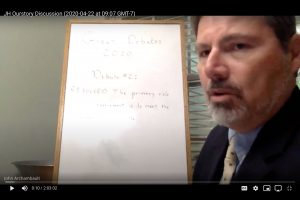 While The Great Debates are usually hosted in the classroom, this year's final debates were argued virtually through Google Hangouts. 57 participants, including students from both Junior High and Upper Elementary, attended the event, deepening their understanding of many forms of government and economic systems, including authoritarian, capitalist, communist, and socialist.
While The Great Debates are usually hosted in the classroom, this year's final debates were argued virtually through Google Hangouts. 57 participants, including students from both Junior High and Upper Elementary, attended the event, deepening their understanding of many forms of government and economic systems, including authoritarian, capitalist, communist, and socialist.
How the Debates Work
Teams of two or three students are given their topic in advance, but they do not learn which side they are on, for or against, until the morning of the debate. As a result, they must analyze and evaluate both sides and research and compile points and examples supporting both arguments. Each student writes two formal position papers, one for each side of the argument. This helps them broaden their thinking and mental flexibility.
 The debates follow a modified version of standard debate procedure, with an opening argument, sometimes shared by two teammates; time for preparation of rebuttal; and then closing arguments and rebuttal, by the remaining member of the team. Faculty members observe, discuss and provide extensive oral feedback to the teams about the debate.
The debates follow a modified version of standard debate procedure, with an opening argument, sometimes shared by two teammates; time for preparation of rebuttal; and then closing arguments and rebuttal, by the remaining member of the team. Faculty members observe, discuss and provide extensive oral feedback to the teams about the debate.
How Topics are Selected
The topics of the debates are drawn from subject matter the students have discussed in history classes during the preceding several weeks. Students are encouraged to go beyond the class discussions in gathering information and building their arguments.
The process allows students to go beyond what they have learned and apply it to larger questions, to develop their reasoning and ability to build and support logical arguments, and to gain confidence and develop greater precision in presenting their thoughts persuasively.
How We Learn
As Junior High students move into and through adolescence, it’s imperative they receive authentic support for their burgeoning philosophical questioning, curiosity in the world around them, and deep desire for belonging within their peer group. Greensboro Montessori School honors these needs through the concept of valorization, which is a pillar of our Junior High curriculum.
Valorization is the process of understanding you are a strong and worthy person. It is the process of self-actualization and fulfillment. It is not about surviving hours of arbitrary homework or memorizing facts for the next test. It’s about completing meaningful work, unleashing academic excellence, and solving real-world problems.
The Great Debates are just one example of how Greensboro Montessori School students experience valorization by developing self-worth, skills, and courage through purpose-filled work. Learn more about how we build valorization through our science curriculum in our recent blog about Trout in the (Indoor, Outdoor, and Virtual) Classroom.
If you are interested in learning more about Greensboro Montessori School's student-centered Upper School serving motivated learners in fourth to ninth grades, we encourage you to schedule a virtual information session. We welcome an opportunity to meet you, learn more about your family, and explore Greensboro Montessori School could partner with your family.
Greensboro Montessori School's Junior High students just culminated one of their project based learning assignments – hatching, growing, and releasing brown trout.
Junior High science teacher, Tim Goetz, released the trout in a cold water tributary of the Smith River near Bassett, Virginia. It was a Friday morning in the middle of the COVID-19 pandemic. Normally, our Junior High students would have been stream-side with Tim, and it would have been their job — not their teacher's — to complete the final step of their semester-long project. Instead, students joined Tim virtually to watch the trout meet their natural habitat.
As the trout grow, they will make their way up river into the Smith River. Along the way, they will eat land and water insects, zooplankton, worms and other aquatic creatures. They will also search for hiding places from predators, including birds and other fish. Tim Key, a member of the Nat Green Fly Fishers Club, who was present at the release said "these are some of the best fish I have every seen."
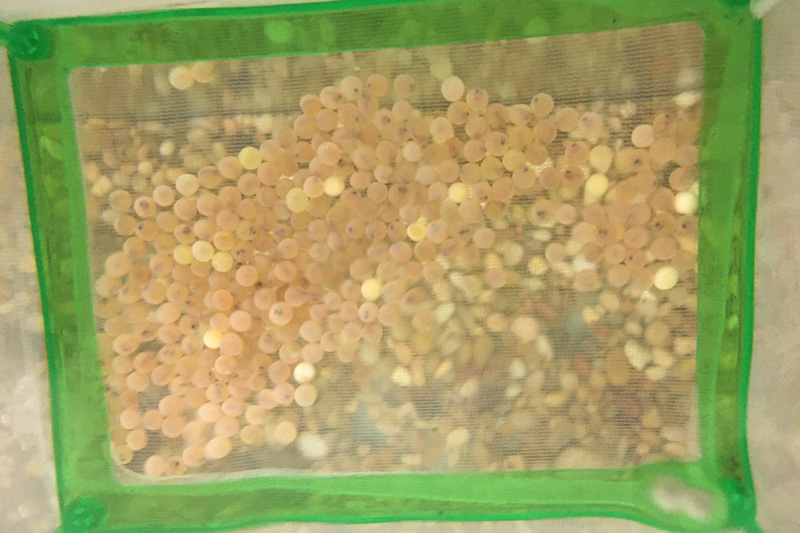 The fish were hatched at Greensboro Montessori School as a part of the nationwide Trout in the Classroom program, with support from the Dan River Basin Association, and Tim Key of the Nat Greene Fly Fishers Club. Over 250 eggs were given to the School on December 5, 2019 and the first hatch was December 10.
The fish were hatched at Greensboro Montessori School as a part of the nationwide Trout in the Classroom program, with support from the Dan River Basin Association, and Tim Key of the Nat Greene Fly Fishers Club. Over 250 eggs were given to the School on December 5, 2019 and the first hatch was December 10.
The fish were raised in a 45-gallon, cold-water aquarium at 50 degrees Fahrenheit in Greensboro Montessori's Upper School. To quickly prepare the correct growing environment, students mixed five gallons of water from the School's pond with 40 gallons of tap water. Students tended to the fish daily, including feeding, changing water, and water testing. Daily water tests included pH, ammonia, and nitrites with the goal of recreating a natural, cold-water trout habitat. This attention to detail resulted in the science room smelling more like an outdoor classroom next to a river than a traditional classroom.
Eighth grade student, Nina, was the head aquarium tender and her classmate, Ava, provided the backdrop art for the aquarium.
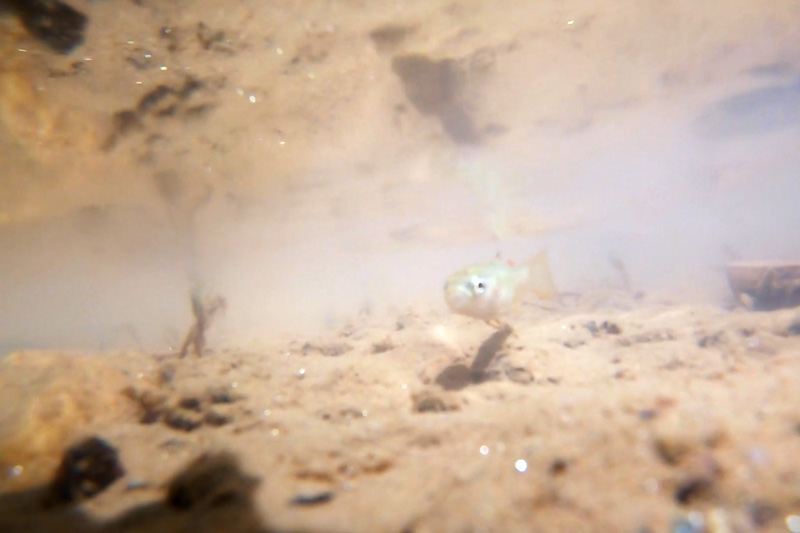 Prior to COVID-19, Junior High students were scheduled to travel to Virginia to release the trout themselves. Their expedition would have been part of their April Land Week, one of several weeks a year when they learn at Greensboro Montessori School's 37-acre satellite campus in Oak Ridge, N.C. With schools throughout the state suspending in-person learning, the students' land week and field trip was cancelled, but not their learning. Students participated in the trout release through a Live Lesson via Google Hangouts. Tim also documented the release on GoPro cameras so he could share the experience with the entire school community, Toddler through Junior High. After all, Greensboro Montessori School students learn everywhere, whether its the indoor, outdoor, or virtual classroom.
Prior to COVID-19, Junior High students were scheduled to travel to Virginia to release the trout themselves. Their expedition would have been part of their April Land Week, one of several weeks a year when they learn at Greensboro Montessori School's 37-acre satellite campus in Oak Ridge, N.C. With schools throughout the state suspending in-person learning, the students' land week and field trip was cancelled, but not their learning. Students participated in the trout release through a Live Lesson via Google Hangouts. Tim also documented the release on GoPro cameras so he could share the experience with the entire school community, Toddler through Junior High. After all, Greensboro Montessori School students learn everywhere, whether its the indoor, outdoor, or virtual classroom.
Learning through purpose-filled, project-based learning — like hatching, raising, and releasing brown trout into their natural habitat — is not the exception to the rule at Greensboro Montessori School. It is the rule. Our students learn through completing meaningful work, which often results in real-world benefits to the community. Through the multistep process of researching, designing, implementing, refining, analyzing, and presenting their projects, our students gain real-world skills such as resiliency, creativity, curiosity, time management, and public speaking. They also develop a sense of self-worth by understanding the value of their contributions to society and experiencing personal fulfillment.
Click here to read about about another real-world project our Junior High students are leading: inoculating, growing, harvesting, and selling shiitake mushrooms.
In addition to Trout in the Classroom, Dan River Basin Association, and Nat Greene Fly Fishers Club, Greensboro Montessori School would like to thank Oliver Rouch from K2 Productions for lending us GoPro cameras and editing our release footage. We also want to thank Tim Key for his work behind the camera.
Another trip to the restroom. That all-important fourth cup of water. Just one more snack to sustain them until daybreak. Isn’t it amazing how young children become such ardent advocates for self-care as the evening hours roll on? Bedtime struggles are a timeless, and trying, rite of parenthood. Just as we’re ready to wrap up the work of the day and enjoy a fleeting moment of grown-up time, our little ones get a second wind, armed with a million urgent reasons to leave their beds. Are afternoon naps to blame for these late-night revivals?
Toward the end of the first Primary year or middle of the second, some parents begin to wonder if eliminating their child’s naps will ease evening bedtime struggles. In some cases, less sleep during the day can indeed help children nod off earlier at night. However, before dropping naps cold turkey, there are some important factors to consider.
The American Academy of Pediatrics supports the American Academy of Sleep Medicine's recommendation that “children 3 to 5 years of age sleep 10 to 13 hours per 24 hours (including naps) on a regular basis to promote optimal health.” With families’ busy lives, this goal can be difficult to attain without the added rest time an afternoon nap provides. Children who have recurring issues with falling asleep at night may not fill their sleep tanks by the time they need to wake for school the next day, leaving them to navigate their mornings foggy and fatigued. Adjusting this pattern by abruptly eliminating a midday rest may result in emotional and behavioral repercussions later in the day, which can put a real damper on family time.
Napping at Greensboro Montessori School
In the Primary napping room at Greensboro Montessori School, we carefully monitor how long and often children sleep at school. When we notice a child is moving away from napping, we communicate with parents to make a transition plan for gradually eliminating afternoon sleep. Depending on the unique needs of each child, we may begin by abbreviating a child’s nap, waking them after a specified period of time. The duration of sleep is decreased little by little, until the child is ready to forego their snooze altogether. When they wake, we offer quiet, engaging activities until it’s time to transition to the car line or our after-school program. For many children, this opportunity to wake slowly and refresh themselves is much less jarring than an abrupt transition to the active Encore classroom or outdoor play spaces.
In other cases, children may outgrow sleeping on their own, while continuing to benefit from remaining in the nap room for a quiet rest and calming activities such as reading, drawing, or listening to music. When the child shows signs of readiness for more stimulation and movement, we work with the family to plan a transition to our Encore classroom (for first-year Primary students), or for the child to remain in their Primary classroom (second-year year Primary students) through the afternoon.
Is it Time?
If you’re uncertain about whether to begin phasing out your child’s naps, please reach out and let us know. Each child is unique, and requires their own individual approach to this transition. We are happy to keep you posted on your child’s sleeping habits at school, and to partner with you to craft a plan that is responsive to your child’s - and your family’s - needs. We can also provide helpful information on other challenges you may be experiencing while getting your little ones to settle in for the night. Though bedtime battles can seem insurmountable, there are effective strategies for giving and getting the rest we all need. Rest assured that your dreams of bedtime independence will eventually come true, and we are here to help you find your way to a truly good night!
Brooke Juneau is the director of CASA at Greensboro Montessori School. In this role, Brooke oversees the School's before- and after-school programming, along with all summer camps. Brooke first joined Greensboro Montessori School as a Toddler teacher in 2013 and served as an anchor for our Toddler students, families, and faculty for six years. She transitioned into her current role in 2019. Brooke holds her Montessori teaching credential in Infant & Toddler Education. She also holds a Bachelor of Arts in education and human development from Hampshire College.



